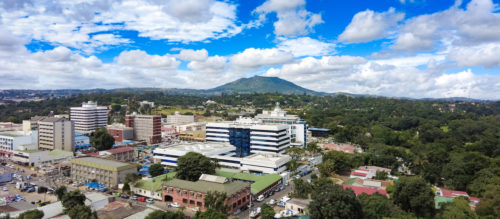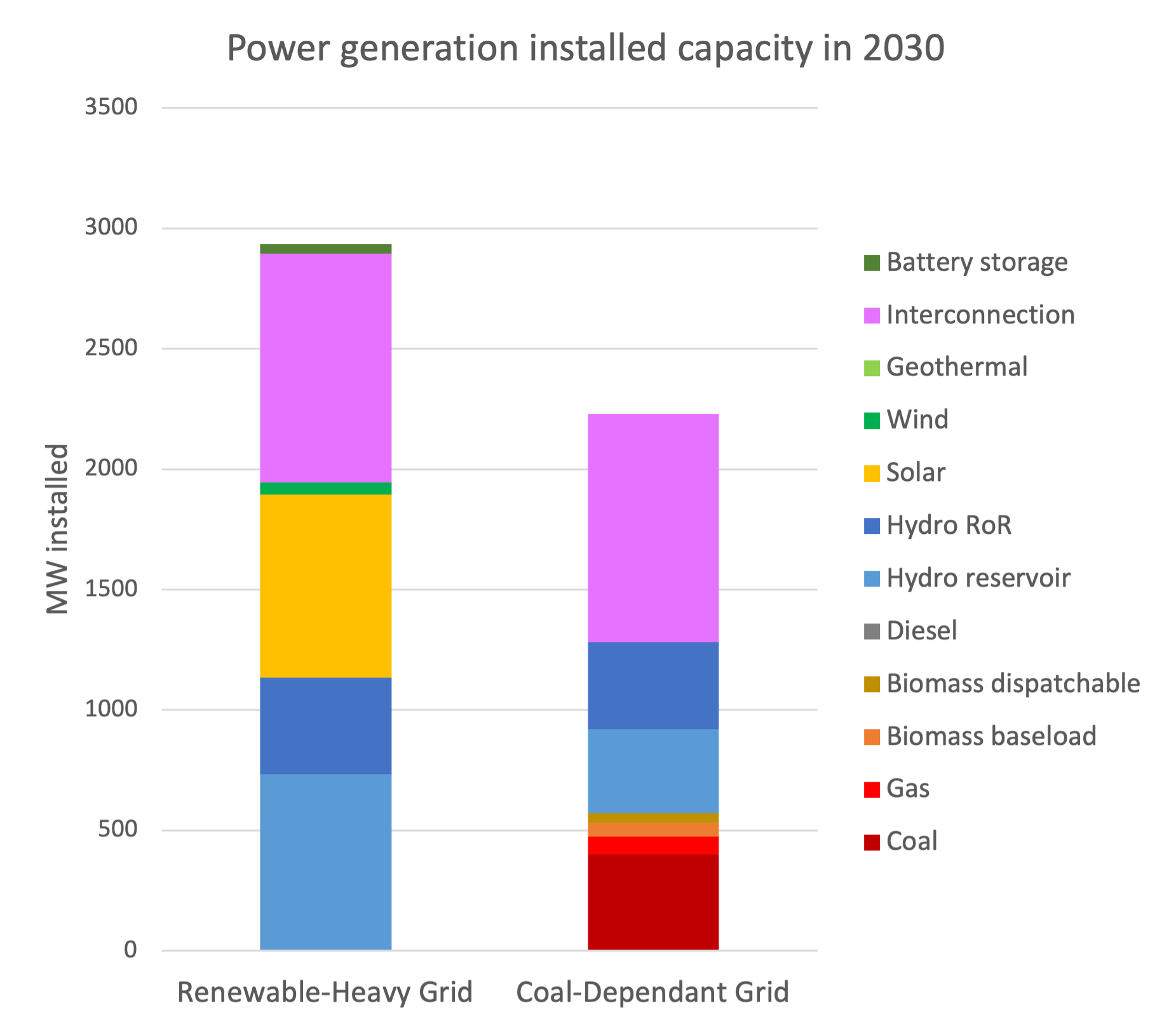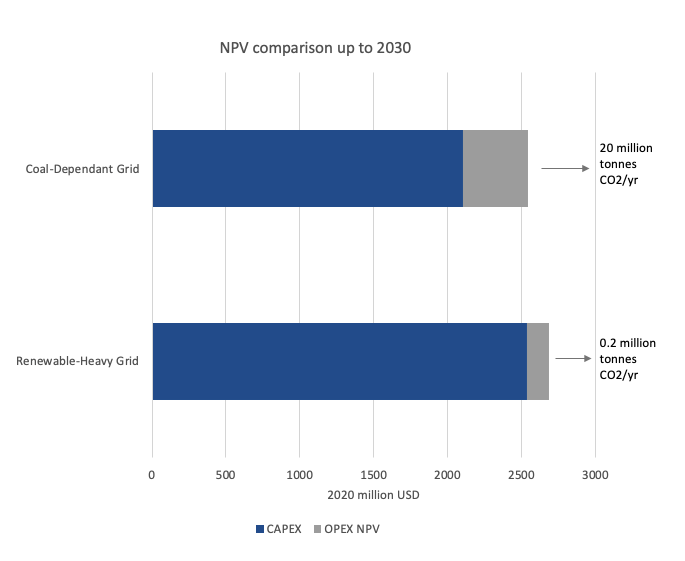DCIM101MEDIADJI_0392.JPG

Move Over Coal. Renewables Can Power Economic Development in Malawi.
Malawi needs more energy. The electric grid of this African country of 19 million can currently meet around 520 MW of peak demand. In contrast, South Africa, with approximately three times the population, can meet a peak electricity demand around a hundred times that of Malawi.
The result? Many Malawians are left without power to run businesses and perform daily activities essential to sustainable economic development. With only 11 per cent of Malawi’s population having access to electricity in 2019 according to the World Bank, it is among the 20 countries with the largest electricity access deficits in the world.
Although the country desperately needs more generation capacity, when considering the scale and options for grid expansion in Malawi, demand uncertainty and climate change inhibit the country’s ability to plan appropriately. Global climate will not be swayed by building a few more fossil plants at this scale. However, decisions on new generation plants will impact rate payers and the economy for years to come.
Meeting energy needs cost-effectively and reliably is also necessary to achieve the Sustainable Development Goal 7 (SDG7) of affordable and clean energy for all by 2030. That is why it is critical to understand the role that different generation plants, especially renewables, can play in meeting grid needs. Below, we describe how policymakers can help accelerate renewable adoption.
Malawi’s Growing Electricity Demand
As the country continues to develop, electricity demand will grow. Currently, the utility is load shedding due to inadequate supply. The government and the national utility, Electricity Supply Corporation of Malawi Limited (ESCOM), are considering run-of-river hydro, hydro reservoir, solar, wind, coal, and gas as generation expansion options, as well as interconnection with neighboring countries including Mozambique, Tanzania, and Zambia.
RMI partnered with UN Office of the High Representative for the least developed countries, landlocked developing countries and small island developing states (UN-OHRLLS) on a project to support least developed countries (LDCs) in achieving SDG7. As part of this project, Malawi was selected as a pilot country to support the government and decision makers in the energy sector on modeling generation expansion options, to understand cost comparisons between different generation mixes and whether a renewable-heavy grid can reliably meet demand.
Electricity demand in Malawi is projected to reach up to three times current levels by 2030 but there is huge uncertainty in how much growth to plan for. In many developing regions, high growth of electricity demand has not materialized. This may be because of slower development pathways or because some parties are incentivized to overstate growth.
Historically in Malawi, new mining industry load has been predicted to significantly increase demand on the grid. However, this has not happened. Therefore, the flexibility in grid planning to be able to respond to changes in demand is critical, as overbuilding generation infrastructure brings serious financial risk for the utility.
Run-of-river hydro makes up 75 percent of Malawi’s grid capacity, with the remainder being diesel generators. This generation mix carries some risk as future hydro potential in the region is uncertain, with some climate models forecasting that river levels will rise while others project levels will fall.
Meanwhile, the diesel peaking plants that were brought on line to meet growing demand have high costs and adverse environmental impacts. We believe that renewable energy can reliably and cost-effectively meet electricity demand and stimulate economic growth in Malawi.
Coal Does Not Provide Unique Grid Value
Some people in the industry have suggested that coal for base load generation is necessary for Malawi’s grid expansion. However, the term “base load” is becoming increasingly outdated. It was used in the past to describe the constant demand on the grid that was met by coal and nuclear plants running continuously at a steady rate. As grids modernize, cost-effective and climate-friendly options are now readily accessible to meet demand reliably without needing to provide base load.
For example, in the US state of Indiana, a major utility, Northern Indiana Public Service Company (NIPSCO), is planning to replace all its coal plants with wind and solar generation. It is estimated that this will save customers US$4 billion over the lifetime of the renewable projects compared with relying on existing coal or investing in new gas plants. In Chile, the Valhalla project, a planned solar PV plant coupled with pumped hydro storage, will provide continuous power, avoiding a fossil base-load plant.
Building coal plants is risky as most coal plants globally are predicted to lose money within the next 20 years due to falling renewable costs, air pollution regulations, and carbon pricing. This could mean early retirement of coal plants, which would impact ratepayers. Also, coal plants are large generation projects that allow less flexibility if demand does not materialize at the rate it is projected.
Further, Malawi will need to import coal. The country has lignite coal, which is not an optimal fuel due to its low energy content, which causes inefficient burning, and its high sulfur content, which makes it the most harmful coal for human health. There are plans to both use local lignite and to import higher quality coal, varying between independent power producers and the parastatal generation company, Electricity Generation Company Malawi Limited (EGENCO).
Renewables Are Cost-Competitive
As part of the project implemented with UN-OHRLLS, RMI built a model to test how different generation expansion options can meet reliability needs. The model analyzes specific grid services like total energy capacity (meeting hourly energy requirements) and peak generation capacity (meeting occasional high power demand) instead of trying to meet base load. This aimed to help inform planning processes, demonstrating whether a renewable-heavy grid could meet requirements cost-competitively, or if coal is indeed the least cost option over a 25- to 30-year period.
Participants from the Ministry of Energy, ESCOM, and Power Markets Limited (the single buyer unit) joined a workshop to validate and learn to use the model. This supported decision makers to explore generation expansion options and compare the impacts of coal and renewables. The model output estimates cost, grid reliability impacts, and the resilience of various grid mixes to changing river levels and different demand projections.
RMI modeling efforts highlighted that an energy mix with hydro and renewables—solar, wind and storage—offers a similar net present value to a grid with hydro, natural gas and coal up to 2030, as shown in the graphics below. Furthermore, a renewable-heavy grid in Malawi can reliably meet peak demand and overall energy needs, addressing national decision makers’ concerns about grid reliability. In grids with high levels of wind and solar, dispatchable gas is usually needed to balance supply. However, hydro reservoir capacity can do this balancing service in Malawi, as reservoirs can be flexibly operated.
Interconnections with neighboring countries also play a critical role through electricity imports to mitigate seasonality effects or climate impacts due to decreased water levels, until more renewable capacity is built. Since future demand and river levels are uncertain, building wind and solar incrementally allows adaptability to changing scenarios.
Indeed, the modularity of renewables enables generation to be built out over time. This prevents the risk of oversupply and minimizes the fiscal burden of a large project while reaping benefits from technology cost reductions. Renewables can meet load cost-competitively and there is no inherent need for coal for baseload. In contrast, a coal-heavy grid leaves less flexibility to adjust to evolving growth projections.
Coordinated Intervention Is Key
As Malawi updates its Integrated Resource Plan (IRP), the findings from RMI’s analysis may be an opportunity to embrace a sustainable development pathway. First, demand should be further studied as today’s unmet demand and future demand growth are largely unknown. Development partners have a key role to play in supporting capacity building to improve accuracy of demand assessment. Next, grid planners should strongly consider medium-sized renewable projects to leverage their fast-paced deployment and modularity benefits. Conversely, larger projects create path dependency.
It is also important for the Ministry to work closely with ESCOM to ensure adequate grid strengthening as increased renewables require more power transmission and more sophisticated grid balancing controls and infrastructure. Development partners can provide technical assistance and directed financial support for grid planning and strengthening initiatives. Lastly, power demand, prices, and other factors will constantly change, so an IRP should keep supply flexible to be able to respond to these changes.
Implementation of an IRP with increased renewable generation will require new funding sources and updated processes for procuring energy. Development partners’ support for the government with tailored financing instruments for renewables will accelerate energy investments and the mobilization of climate financing. With such tools available, there are strong signals that competitive procurement of renewables via energy auctions will unlock swift renewable project deployment. The critical enabler in this pathway for renewables adoption will be development partners’ support in capacity building to fast-track the design and implementation of auctions.
RMI analysis highlights renewable generation’s critical contribution to reliable and cost-competitive electricity supply in Malawi due to the major hydro resource. Furthermore, costs related to health and environmental impacts of coal were not included in the analysis, which would increase the competitiveness of renewables. Renewables also provide an opportunity for economic growth through job creation related to construction and maintenance.
Ultimately, renewable energy can provide affordable and reliable electricity to meet economic and sustainable development objectives. To fully reap the promised benefits of clean energy, coordinated intervention from the Malawi government coupled with support from development partners is necessary to design and implement an IRP with increased renewables. This will help drive Malawi toward a modernized, reliable, and low-cost grid.

